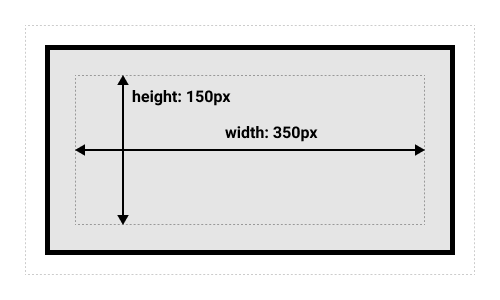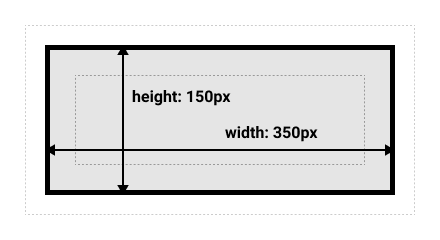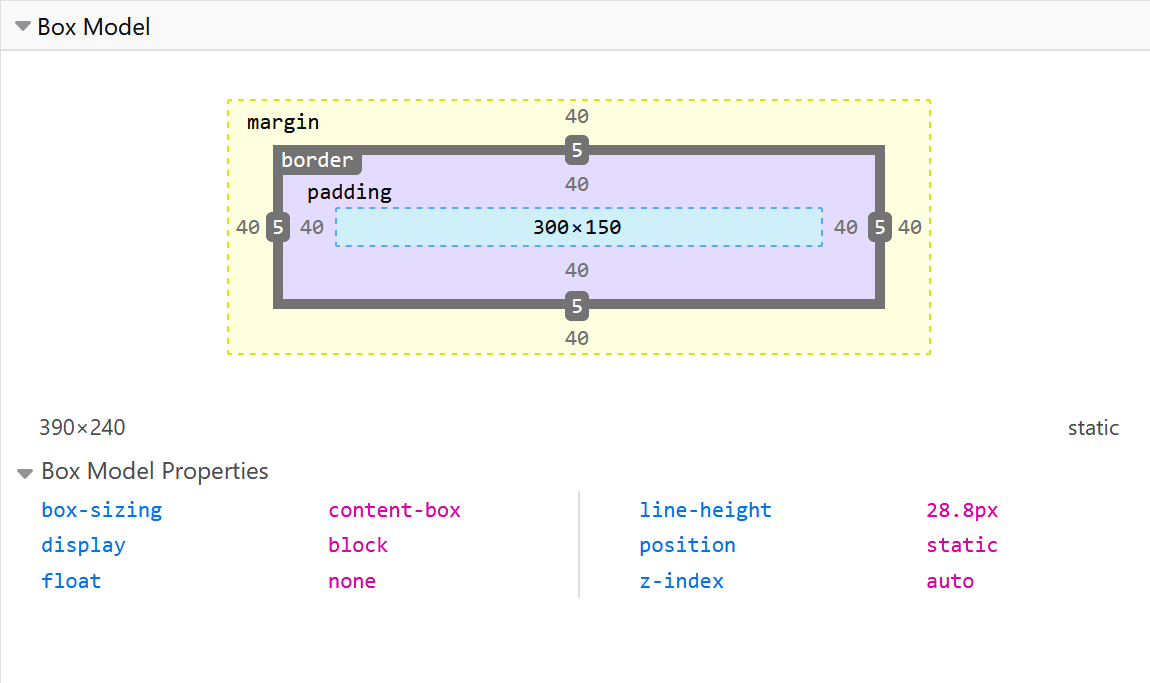The box model
Everything in CSS has a box around it, and understanding these boxes is key to being able to create more complex layouts with CSS, or to align items with other items. In this lesson, we will take a look at the CSS Box Model. You'll get an understanding of how it works and the terminology that relates to it.
| Prerequisites: | Basic computer literacy, basic software installed, basic knowledge of working with files, HTML basics (study Introduction to HTML), and an idea of how CSS works (study CSS first steps.) |
|---|---|
| Objective: | To learn about the CSS Box Model, what makes up the box model and how to switch to the alternate model. |
Block and inline boxes
In CSS we have several types of boxes that generally fit into the categories of block boxes and inline boxes. The type refers to how the box behaves in terms of page flow and in relation to other boxes on the page. Boxes have an inner display type and an outer display type.
In general, you can set various values for the display type using the display property, which can have various values.
Outer display type
If a box has an outer display type of block, then:
- The box will break onto a new line.
- The
widthandheightproperties are respected. - Padding, margin and border will cause other elements to be pushed away from the box.
- If
widthis not specified, the box will extend in the inline direction to fill the space available in its container. In most cases, the box will become as wide as its container, filling up 100% of the space available.
Some HTML elements, such as <h1> and <p>, use block as their outer display type by default.
If a box has an outer display type of inline, then:
- The box will not break onto a new line.
- The
widthandheightproperties will not apply. - Top and bottom padding, margins, and borders will apply but will not cause other inline boxes to move away from the box.
- Left and right padding, margins, and borders will apply and will cause other inline boxes to move away from the box.
Some HTML elements, such as <a>, <span>, <em> and <strong> use inline as their outer display type by default.
Inner display type
Boxes also have an inner display type, which dictates how elements inside that box are laid out.
Block and inline layout is the default way things behave on the web. By default and without any other instruction, the elements inside a box are also laid out in normal flow and behave as block or inline boxes.
You can change the inner display type for example by setting display: flex;. The element will still use the outer display type block but this changes the inner display type to flex. Any direct children of this box will become flex items and behave according to the Flexbox specification.
When you move on to learn about CSS Layout in more detail, you will encounter flex, and various other inner values that your boxes can have, for example grid.
Note: To read more about the values of display, and how boxes work in block and inline layout, take a look at the MDN guide Block and Inline Layout.
Examples of different display types
The example below has three different HTML elements, all of which have an outer display type of block.
- A paragraph with a border added in CSS. The browser renders this as a block box. The paragraph starts on a new line and extends the entire available width.
- A list, which is laid out using
display: flex. This establishes flex layout for the children of the container, which are flex items. The list itself is a block box and — like the paragraph — expands to the full container width and breaks onto a new line. - A block-level paragraph, inside which are two
<span>elements. These elements would normally beinline, however, one of the elements has a class of "block" which gets set todisplay: block.
In the next example, we can see how inline elements behave.
- The
<span>elements in the first paragraph are inline by default and so do not force line breaks. - The
<ul>element that is set todisplay: inline-flexcreates an inline box containing some flex items. - The two paragraphs are both set to
display: inline. The inline flex container and paragraphs all run together on one line rather than breaking onto new lines (as they would do if they were displaying as block-level elements).
To toggle between the display modes, you can change display: inline to display: block or display: inline-flex to display: flex.
The key thing to remember for now is: Changing the value of the display property can change whether the outer display type of a box is block or inline. This changes the way it displays alongside other elements in the layout.
What is the CSS box model?
The CSS box model as a whole applies to block boxes and defines how the different parts of a box — margin, border, padding, and content — work together to create a box that you can see on a page. Inline boxes use just some of the behavior defined in the box model.
To add complexity, there is a standard and an alternate box model. By default, browsers use the standard box model.
Parts of a box
Making up a block box in CSS we have the:
- Content box: The area where your content is displayed; size it using properties like
inline-sizeandblock-sizeorwidthandheight. - Padding box: The padding sits around the content as white space; size it using
paddingand related properties. - Border box: The border box wraps the content and any padding; size it using
borderand related properties. - Margin box: The margin is the outermost layer, wrapping the content, padding, and border as whitespace between this box and other elements; size it using
marginand related properties.
The below diagram shows these layers:

The standard CSS box model
In the standard box model, if you give a box an inline-size and a block-size (or width and a height) attributes, this defines the inline-size and block-size (width and height in horizontal languages) of the content box. Any padding and border is then added to those dimensions to get the total size taken up by the box (see image below).
If we assume that a box has the following CSS:
.box {
width: 350px;
height: 150px;
margin: 10px;
padding: 25px;
border: 5px solid black;
}
The actual space taken up by the box will be 410px wide (350 + 25 + 25 + 5 + 5) and 210px high (150 + 25 + 25 + 5 + 5).

Note: The margin is not counted towards the actual size of the box — sure, it affects the total space that the box will take up on the page, but only the space outside the box. The box's area stops at the border — it does not extend into the margin.
The alternative CSS box model
In the alternative box model, any width is the width of the visible box on the page. The content area width is that width minus the width for the padding and border (see image below). No need to add up the border and padding to get the real size of the box.
To turn on the alternative model for an element, set box-sizing: border-box on it:
.box {
box-sizing: border-box;
}
If we assume the box has the same CSS as above:
.box {
width: 350px;
inline-size: 350px;
height: 150px;
block-size: 150px;
margin: 10px;
padding: 25px;
border: 5px solid black;
}
Now, the actual space taken up by the box will be 350px in the inline direction and 150px in the block direction.

To use the alternative box model for all of your elements (which is a common choice among developers), set the box-sizing property on the <html> element and set all other elements to inherit that value:
html {
box-sizing: border-box;
}
*,
*::before,
*::after {
box-sizing: inherit;
}
To understand the underlying idea, you can read the CSS Tricks article on box-sizing.
Playing with box models
In the example below, you can see two boxes. Both have a class of .box, which gives them the same width, height, margin, border, and padding. The only difference is that the second box has been set to use the alternative box model.
Can you change the size of the second box (by adding CSS to the .alternate class) to make it match the first box in width and height?
Note: You can find a solution for this task here.
Use browser DevTools to view the box model
Your browser developer tools can make understanding the box model far easier. If you inspect an element in Firefox's DevTools, you can see the size of the element plus its margin, padding, and border. Inspecting an element in this way is a great way to find out if your box is really the size you think it is!

Margins, padding, and borders
You've already seen the margin, padding, and border properties at work in the example above. The properties used in that example are shorthands and allow us to set all four sides of the box at once. These shorthands also have equivalent longhand properties, which allow control over the different sides of the box individually.
Let's explore these properties in more detail.
Margin
The margin is an invisible space around your box. It pushes other elements away from the box. Margins can have positive or negative values. Setting a negative margin on one side of your box can cause it to overlap other things on the page. Whether you are using the standard or alternative box model, the margin is always added after the size of the visible box has been calculated.
We can control all margins of an element at once using the margin property, or each side individually using the equivalent longhand properties:
In the example below, try changing the margin values to see how the box is pushed around due to the margin creating or removing space (if it is a negative margin) between this element and the containing element.
Margin collapsing
Depending on whether two elements whose margins touch have positive or negative margins, the results will be different:
- Two positive margins will combine to become one margin. Its size will be equal to the largest individual margin.
- Two negative margins will collapse and the smallest (furthest from zero) value will be used.
- If one margin is negative, its value will be subtracted from the total.
In the example below, we have two paragraphs. The top paragraph has a margin-bottom of 50 pixels, the other has a margin-top of 30 pixels. The margins have collapsed together so the actual margin between the boxes is 50 pixels and not the total of the two margins.
You can test this by setting the margin-top of paragraph two to 0. The visible margin between the two paragraphs will not change — it retains the 50 pixels set in the margin-bottom of paragraph one. If you set it to -10px, you'll see that the overall margin becomes 40px — it subtracts from the 50px.
A number of rules dictate when margins do and do not collapse. For further information see the detailed page on mastering margin collapsing. The main thing to remember is that margin collapsing is a thing that happens if you are creating space with margins and don't get the space you expect.
Borders
The border is drawn between the margin and the padding of a box. If you are using the standard box model, the size of the border is added to the width and height of the content box. If you are using the alternative box model then the size of the border makes the content box smaller as it takes up some of that available width and height of the element box.
For styling borders, there are a large number of properties — there are four borders, and each border has a style, width, and color that we might want to manipulate.
You can set the width, style, or color of all four borders at once using the border property.
To set the properties of each side individually, use:
To set the width, style, or color of all sides, use:
To set the width, style, or color of a single side, use one of the more granular longhand properties:
border-top-widthborder-top-styleborder-top-colorborder-right-widthborder-right-styleborder-right-colorborder-bottom-widthborder-bottom-styleborder-bottom-colorborder-left-widthborder-left-styleborder-left-color
In the example below, we have used various shorthands and longhands to create borders. Play around with the different properties to check that you understand how they work. The MDN pages for the border properties give you information about the different available border styles.
Padding
The padding sits between the border and the content area and is used to push the content away from the border. Unlike margins, you cannot have a negative padding. Any background applied to your element will display behind the padding.
The padding property controls the padding on all sides of an element. To control each side individually, use these longhand properties:
In the example below, you can change the values for padding on the class .box to see that this changes where the text begins in relation to the box. You can also change the padding on the class .container to create space between the container and the box. You can change the padding on any element to create space between its border and whatever is inside the element.
The box model and inline boxes
All of the above fully applies to block boxes. Some of the properties can apply to inline boxes too, such as those created by a <span> element.
In the example below, we have a <span> inside a paragraph. We have applied a width, height, margin, border, and padding to it. You can see that the width and height are ignored. The top and bottom margin, padding, and border are respected but don't change the relationship of other content to our inline box. The padding and border overlap other words in the paragraph. The left and right padding, margins, and borders move other content away from the box.
Using display: inline-block
display: inline-block is a special value of display, which provides a middle ground between inline and block. Use it if you do not want an item to break onto a new line, but do want it to respect width and height and avoid the overlapping seen above.
An element with display: inline-block does a subset of the block things we already know about:
- The
widthandheightproperties are respected. padding,margin, andborderwill cause other elements to be pushed away from the box.
It does not, however, break onto a new line, and will only become larger than its content if you explicitly add width and height properties.
In this next example, we have added display: inline-block to our <span> element. Try changing this to display: block or removing the line completely to see the difference in display models.
Where this can be useful is when you want to give a link a larger hit area by adding padding. <a> is an inline element like <span>; you can use display: inline-block to allow padding to be set on it, making it easier for a user to click the link.
You see this fairly frequently in navigation bars. The navigation below is displayed in a row using flexbox and we have added padding to the <a> element as we want to be able to change the background-color when the <a> is hovered. The padding appears to overlap the border on the <ul> element. This is because the <a> is an inline element.
Add display: inline-block to the rule with the .links-list a selector, and you will see how it fixes this issue by causing the padding to be respected by other elements.
Test your skills!
You've reached the end of this article, but can you remember the most important information? You can find some further tests to verify that you've retained this information before you move on — see Test your skills: The box model.
Summary
That's most of what you need to understand about the box model. You may want to return to this lesson in the future if you ever find yourself confused about how big boxes are in your layout.
In the next article, we'll take a look at how backgrounds and borders can be used to make your plain boxes look more interesting.